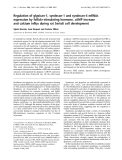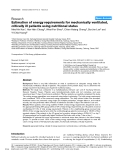
Nutritional requirements
-
Street foods and restaurant foods play a significant role in people‟s day-to-day food options as well as their consistent nutritional requirements are dependent on these foods. As their ever-growing demanding schedule take away the chance to eat homemade food. Due to convenient availability, these eateries foods are one of the primary food choices especially for city people. Over the years, many food-borne diseases have been appeared due to contaminated non-homemade food intake.
 12p
12p  nguaconbaynhay6
nguaconbaynhay6
 24-06-2020
24-06-2020
 9
9
 0
0
 Download
Download
-
In seminiferous tubules, Sertoli cells provide structural and nutritional support for the developing germinal cells. Cellto-cell signaling and cell adhesion require proteoglycans expressed at the cell membrane. A preliminary biochemical and structural approach indicated that cell surface proteoglycans are mostly heparan sulfate proteoglycans (HSPG). Glypican-1, syndecans-1 and -4 were identified using a molecular approach.
 9p
9p  research12
research12
 01-06-2013
01-06-2013
 41
41
 5
5
 Download
Download
-
Tuyển tập các báo cáo nghiên cứu về y học được đăng trên tạp chí y học Critical Care giúp cho các bạn có thêm kiến thức về ngành y học đề tài: Estimation of energy requirements for mechanically ventilated, critically ill patients using nutritional status...
 8p
8p  coxanh_2
coxanh_2
 23-10-2011
23-10-2011
 61
61
 4
4
 Download
Download
-
Infection with Viridans Streptococci: Treatment Isolates from neutropenic patients with bacteremia are often resistant to penicillin; thus these patients should be treated presumptively with vancomycin until the results of susceptibility testing become available. Viridans streptococci isolated in other clinical settings usually are sensitive to penicillin. Abiotrophia Species (Nutritionally Variant Streptococci) Occasional isolates cultured from the blood of patients with endocarditis fail to grow when subcultured on solid media.
 5p
5p  colgate_colgate
colgate_colgate
 21-12-2010
21-12-2010
 87
87
 4
4
 Download
Download
-
Vaccine Patients recovering from tetanus should be actively immunized (see below) because immunity is not induced by the small amount of toxin required to produce disease. Additional Measures Like all patients receiving ventilatory support, patients with tetanus require attention to hydration; nutrition; physiotherapy; prophylactic anticoagulation; bowel, bladder, and renal function; decubitus ulcer prevention; and treatment of intercurrent infection.
 8p
8p  colgate_colgate
colgate_colgate
 21-12-2010
21-12-2010
 52
52
 2
2
 Download
Download
-
Harrison's Internal Medicine Chapter 74. Biology of Obesity Biology of Obesity: Introduction In a world where food supplies are intermittent, the ability to store energy in excess of what is required for immediate use is essential for survival. Fat cells, residing within widely distributed adipose tissue depots, are adapted to store excess energy efficiently as triglyceride and, when needed, to release stored energy as free fatty acids for use at other sites.
 5p
5p  konheokonmummim
konheokonmummim
 03-12-2010
03-12-2010
 72
72
 4
4
 Download
Download
-
Table 73-10 Enteral Formulas Composition Characteristics Clinical Indications STANDARD ENTERAL FORMULA 1. Complete dietary products (+)a Suitable for most patients requiring tube feeding; some can be a. Caloric density 1 kcal/mL used orally b. Protein ~14% cals, caseinates, soy, lactalbumin c. CHO ~60% cals, hydrolyzed corn starch, maltodextrin, sucrose d. Fat ~30% cals, corn, soy, safflower oils e. Recommended daily intake of all minerals and vitamins in 1500 kcal/d f. Osmolality (mosmol/kg): ~300 MODIFIED ENTERAL FORMULAS 1. Caloric density 1.
 5p
5p  konheokonmummim
konheokonmummim
 03-12-2010
03-12-2010
 88
88
 5
5
 Download
Download
-
Protein or Amino Acid Requirements Although the recommended dietary allowance for protein is 0.8 g/kg per d, maximal rates of repletion occur with 1.5 g/kg in the malnourished. In the severely catabolic patient, this higher level minimizes protein loss. In patients requiring SNS in the acute care setting, at least 1 g/kg is recommended, with greater amounts up to 1.5 g/kg as volume, renal, and hepatic tolerances allow. The standard parenteral and enteral formulas contain protein of high biologic value and meet the requirements for the eight essential amino acids.
 6p
6p  konheokonmummim
konheokonmummim
 03-12-2010
03-12-2010
 61
61
 4
4
 Download
Download
-
Energy Requirements Total energy expenditure comprises resting energy expenditure (two-thirds) plus activity energy expenditure (one-third) (Chap. 72). Resting energy expenditure includes the calories necessary for basal metabolism at bed rest. Activity energy expenditure represents one-fourth to one-third of the total, and the thermal effect of feeding is about 10% of the total energy expenditure. For normally nourished healthy individuals, the total energy expenditure is about 30– 35 kcal/kg.
 5p
5p  konheokonmummim
konheokonmummim
 03-12-2010
03-12-2010
 86
86
 4
4
 Download
Download
-
Disease-Specific Nutritional Support SNS is basically a support therapy and is primary therapy only for the treatment or prevention of malnutrition. Certain conditions require modification of nutritional support because of organ or system impairment. For instance, in nitrogen accumulation disorders, protein intake may need to be reduced. However, in renal disease, except for brief periods of several days, protein intakes should approach requirement levels of at least 0.8 g/kg or higher up to 1.2 g/kg as long as the blood urea nitrogen does not exceed 100 mg/dL.
 5p
5p  konheokonmummim
konheokonmummim
 03-12-2010
03-12-2010
 77
77
 5
5
 Download
Download
-
Efficacy of SNS in Different Disease States Efficacy studies have shown that malnourished patients undergoing major thoracoabdominal surgery benefit from SNS. Critical illness requiring ICU care including major burns, major trauma, severe sepsis, closed head injury, and severe pancreatitis [positive CT scan and Acute Physiology and Chronic Health Evaluation II (APACHE II) 10] all benefit by early SNS, as indicated by reduced mortality and morbidity. In critical illness, initiation of SNS within 24 h of injury or ICU admission is associated with a ~50% reduction in mortality.
 5p
5p  konheokonmummim
konheokonmummim
 03-12-2010
03-12-2010
 67
67
 5
5
 Download
Download
-
Nutritional History A nutritional history is directed toward identifying underlying mechanisms that put patients at risk for nutritional depletion or excess. These mechanisms include inadequate intake, impaired absorption, decreased utilization, increased losses, and increased requirements of nutrients. Individuals with the characteristics listed in Table 72-3 are at particular risk for nutritional deficiencies.
 9p
9p  konheokonmummim
konheokonmummim
 03-12-2010
03-12-2010
 55
55
 5
5
 Download
Download
-
Harrison's Internal Medicine Chapter 72. Malnutrition and Nutritional Assessment Malnutrition and Nutritional Assessment: Introduction Malnutrition can arise from primary or secondary causes, with the former resulting from inadequate or poor-quality food intake and the latter from diseases that alter food intake or nutrient requirements, metabolism, or absorption. Primary malnutrition occurs mainly in developing countries and under conditions of war or famine.
 6p
6p  konheokonmummim
konheokonmummim
 03-12-2010
03-12-2010
 51
51
 5
5
 Download
Download
-
Nutritional Status Assessment Full nutritional status assessment is reserved for seriously ill patients and those at very high nutritional risk when the cause of malnutrition is still uncertain after initial clinical evaluation and dietary assessment. It involves multiple dimensions, including documentation of dietary intake, anthropometric measurements, biochemical measurements of blood and urine, clinical examination, health history, and functional status. For further discussion of nutritional assessment, see Chap. 72.
 4p
4p  konheokonmummim
konheokonmummim
 03-12-2010
03-12-2010
 81
81
 5
5
 Download
Download
-
Acute Care Settings Acute care settings, anorexia, various diseases, test procedures, and medications can compromise dietary intake. Under such circumstances, the goal is to identify and avoid inadequate intake and ensure appropriate alimentation. Dietary assessment focuses on what patients are currently eating, whether they are able and willing to eat, and whether they experience any problems with eating. Dietary intake assessment is based on information from observed intakes; medical record; history; clinical examination; and anthropometric, biochemical, and functional status.
 7p
7p  konheokonmummim
konheokonmummim
 03-12-2010
03-12-2010
 81
81
 4
4
 Download
Download
-
Physiologic Factors Growth, strenuous physical activity, pregnancy, and lactation increase needs for energy and several essential nutrients, including water. Energy needs rise during pregnancy, due to the demands of fetal growth, and during lactation, because of the increased energy required for milk production. Energy needs decrease with loss of lean body mass, the major determinant of REE. Because both health and physical activity tend to decline with age, energy needs in older persons, especially those over 70, tend to be less than those of younger persons.
 5p
5p  konheokonmummim
konheokonmummim
 03-12-2010
03-12-2010
 73
73
 4
4
 Download
Download
-
Estimated Average Requirement When florid manifestations of the classic dietary deficiency diseases such as rickets, scurvy, xerophthalmia, and protein-calorie malnutrition were common, nutrient adequacy was inferred from the absence of their clinical signs. Later, it was determined that biochemical and other changes were evident long before the clinical deficiency became apparent. Consequently, criteria of nutrient adequacy are now based on biologic markers when they are available.
 5p
5p  konheokonmummim
konheokonmummim
 03-12-2010
03-12-2010
 71
71
 4
4
 Download
Download
-
Note: This table presents recommended dietary allowances (RDAs) in bold type and adequate intakes (AIs) in ordinary type. RDAs and AIs may both be used as goals for individual intake. RDAs are set to meet the needs of almost all individuals (97 to 98%) in a group. For healthy breastfed infants, the AI is the mean intake. The AI for other life stage and gender groups is believed to cover needs of all individuals in the group, but lack of data or uncertainty in the data prevent being able to specify with confidence the percentage of individuals covered by...
 9p
9p  konheokonmummim
konheokonmummim
 03-12-2010
03-12-2010
 85
85
 4
4
 Download
Download
-
Water For adults, 1.0–1.5 mL water per kcal of energy expenditure is sufficient under usual conditions to allow for normal variations in physical activity, sweating, and solute load of the diet. Water losses include 50–100 mL/d in the feces, 500–1000 mL/d by evaporation or exhalation, and, depending on the renal solute load, ≥1000 mL/d in the urine. If external losses increase, intakes must increase accordingly to avoid underhydration. Fever increases water losses by approximately 200 mL/d per °C; diarrheal losses vary but may be as great as 5 L/d with severe diarrhea.
 8p
8p  konheokonmummim
konheokonmummim
 03-12-2010
03-12-2010
 77
77
 5
5
 Download
Download
-
Harrison's Internal Medicine Chapter 70. Nutritional Requirements and Dietary Assessment Nutritional Requirements and Dietary Assessment: Introduction Nutrients are substances that must be supplied by the diet because they are not synthesized in the body in sufficient amounts. Nutrient requirements for groups of healthy persons have been determined experimentally. For good health we require energy-providing nutrients (protein, fat, and carbohydrate), vitamins, minerals, and water.
 5p
5p  konheokonmummim
konheokonmummim
 03-12-2010
03-12-2010
 90
90
 8
8
 Download
Download
CHỦ ĐỀ BẠN MUỐN TÌM
































